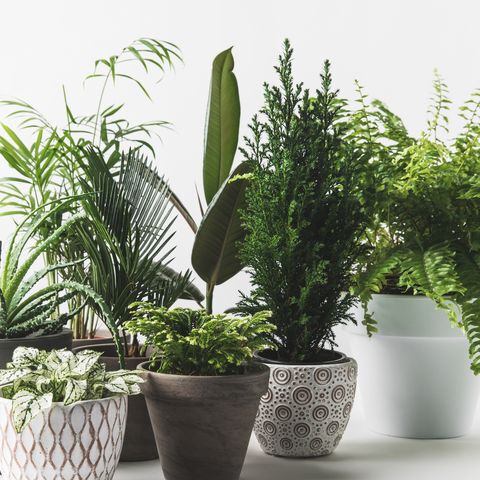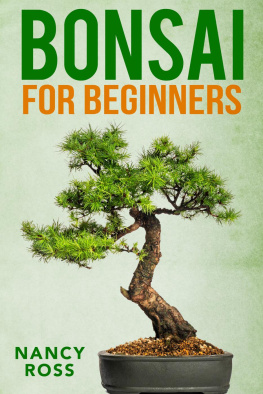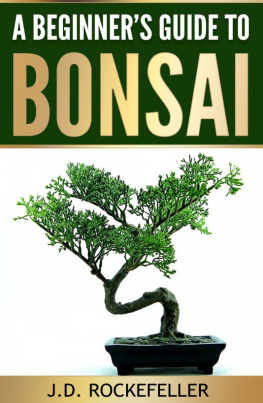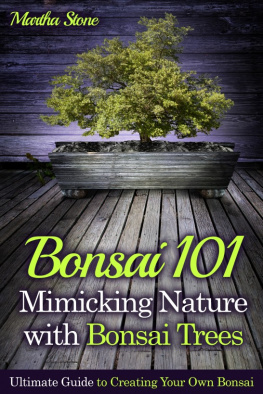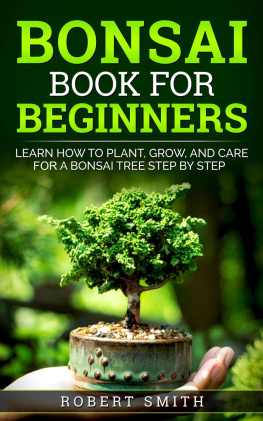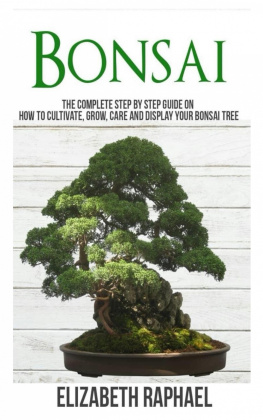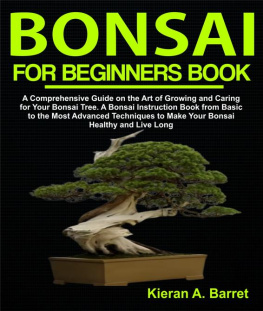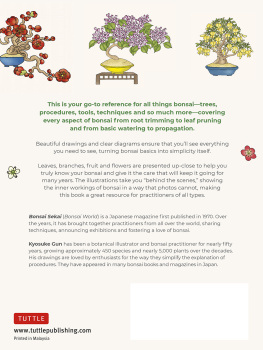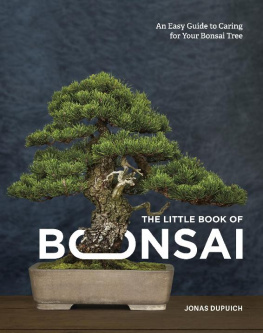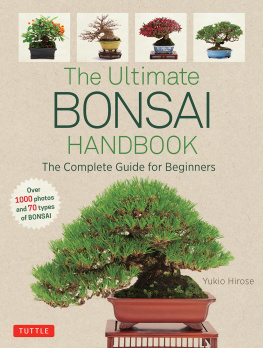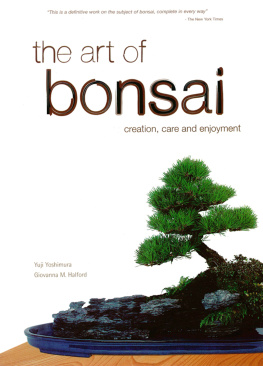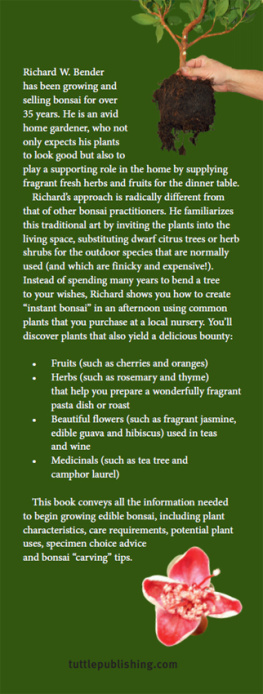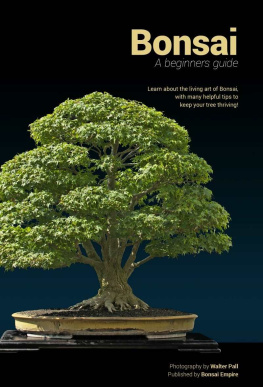Anne Duval
BONSAI
and
Houseplants
for Beginners
A Complete Guide to Choose, Grow and Take Care of your Bonsai and Houseplants
Cright 2021 ublihing.
All right rrvd.
Author: Anne Duval
N part f thi ublitin m be rrdud, ditributd or transmitted in n frm or by any mn, including hting rrding r other electronic r mhnil mthd or b n infrmtin trg and rtrivl tm without th prior writtn permission of the ublihr, xt in th case f brif uttin mbdi in ritil reviews and rtin other nn-mmril u rmittd b right lw.
Table of Contents
BOOK 1: Bonsai for Beginners
BOOK 2: Houseplants for Beginners
Anne Duval
BONSAI
for Beginners
A Complete Guide to Grow and Take Care of your Bonsai, besides knowing History, Styles and the different species of legendary Japanese Tree
Introduction
The definition of the term "Bonsai" is a plant, usually a tree or a shrub, which is cultivated in a container and made to look like a mature tree through the use of various training techniques. Usually, the plant does not exceed 1 meter in height. The art of Bonsai, as we know it, dates back to 2,000 years. The term bonsai is made up of two Japanese characters or words, "bon" and "sai," "bon" is a bowl, a tray or a jar, "sai" is a tree or a potted planting. The term Bonsai applies equally to indoor and outdoor plants. The original word Bonsai derives from the Chinese word "P'en Tsai" which sounds similar to bonsai and has almost the same meaning. It could not be further from the true spirit of the bonsai if we were to narrow our understanding in this way. It is indeed a plant in a bowl, but a tree that has been exposed to a range of horticultural and esthetic disciplines through which visual equilibrium and botanical well-being are attained. The purpose of the traditional Bonsai is to create a balanced miniature image of the fruit.
The ultimate challenge for the maker of Bonsai is to reveal the essence of the tree. Bonsai's craft is to tell a story by living hallucinations. The artist aims to explore ways of expressing himself within the boundaries of successful horticultural practice. Bonsai is a fun mixture of shape, feeling, and suggestion in a miniature world; and, like all good art, it endures.
Beginners and students also have the same concern: the ability to maintain a safe crop. The goal is to be able to control the degree of pressure that the plant can bear to remain healthy. "Stress" is not an emotional stress, but a reference to the horticultural tradition of being able to know how much is too much, and how much is too little. This principle applies to all facets of Bonsai nature, including wind, water, soil, light, nutrients, temperature, elevation, pruning, etc. The goal is to have the willingness to learn, to test and to accept the results of these efforts. Time is another central aspect of Bonsai. The cycle of development takes time, and there are no shortcuts. A that year is the normal yardstick to measure success. Caring about the Bonsai generates a profound sense of satisfaction over time. There is no substitution for time; it's always continuous and going on. It is said that one will know more than Bonsai through the study of Bonsai.
Bonsai is about plants, a small forest. It's also about time and space and about cultureand attitudes. Historically, Bonsai has been a part of culture, an important part of family heritage. Similarly, Bonsai can literally be a past horticultural period needing nothing more than a measure of common sense in planting, some artistic ability, and a great deal of patience.
Mark Patterson, an enthusiastic bonsai enthusiast and owner of Urban Oasis Bonsai, spoke to HCP horticultural students about Bonsai design.
Mark clarified that bonsai is a horticultural and artistic practice, not an organism or an unusual Japanese tree. The term bonsai literally translates as "planting in a bowl." The plants used for bonsai are regular shrubs and trees that are formed in miniature sizes by pruning all branches and roots. Most of the bonsai were indoor plants.
Yet bonsai is also a form of art, like a painting or a sculpture. The art of choosing a tree, observing and learning from a leaf, and then using specific techniques of pruning, wiring and care to create a miniaturized, live plant sculpture.
Bonsai can't be cared for or conceived of as a house plant. You have to visit the tree every day, spend five minutes a day, observe it closely every day, decide when to drink, pinch and cut. Bonsai growers are very close to their plants, and they know every branch personally.
Important elements of the bonsai include the shape of the trunk, the rotation of the roots and branches, the outline, the branching and the root pruning. Plant type and soil composition are also very special to bonsai.
The trunk is one of the most eye-catching characteristics of the tree, it should be thinner at its base than at the top of the tree, think of taper, taper, taper. Mark clarified that at some stage he would look at 400 trees in a nursery to find a good bonsai collection.
Movement, whether the trunk travels to the left or to the right or to the S, generates excitement and is appreciated for the production of bonsai. Movement is also generated by the unique zigzag pruning technique used in bonsai called the law of two. The law of the two suggests that you always cut back from two internships. Of eg, the first cut is down to two interns, the new stems must expand at the cutting site, and then they will be pruned to the law of twos, etc. This cycle creates an interesting, complicated thickening division that gives form and defines the area. The Bonsai silhouette is usually triangular. When pruning, it is important to remember that bonsai is intended to replicate nature and base the form of your tree on its existence as a normal size plant.
The bonsai pot is very critical, and the plants must be in a decent bonsai pot to be called bonsai. Bonsai pots are much smaller, thinner, flatter than traditional western pots. A bonsai may be grown in a larger pot for more health and comfort, but it is transferred to a bonsai pot for show. The effect of the pot and display of the bonsai is an expression of the bonsai artist.
Bonsai is cultivated in different soil; a special mix exclusive to every bonsai enthusiast. Mark uses his own mix of lava rock, sea sand, granite #2 and pine bark. Bonsai soil is a mixture designed to allow a lot of air to penetrate the soil, provide good drainage and still maintain enough moisture during watering.
Root pruning is another special and important component in the development of bonsai. Root pruning produces a tiny root mass so that the tree can fall into a small container. Roots behave similar to branches when they are pruned; rising from the end when they are trimmed. As with all pruning, timing and quantity are important to allow the tree to regenerate, expand and continue to thrive.
A highlight of our exposure to bonsai was a description of how to apply bonsai techniques to boxwood. The process of creating a bonsai became easier as Mark spoke to us through the steps and encouraged students to get close and personal and prune several branches. There are many different devices for Bonsai, but the boxwood was delicate enough to be formed. Mark also demonstrated how to root the prune and repot the bonsai to the correct bonsai jar. He used a different tree for root example, as he explained, you're not expected to do appendix surgery or stomach surgery on the day.
Although the art of bonsai takes years to master, Mark's talk and demos gave us a brief glimpse of the thrill of making bonsai.

